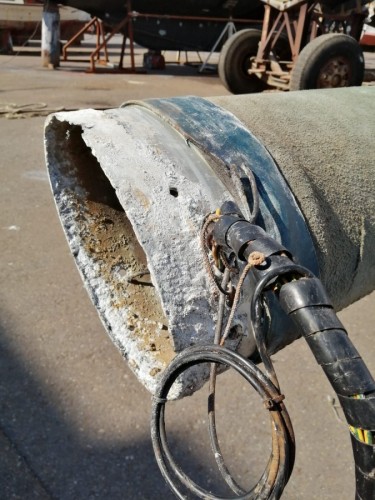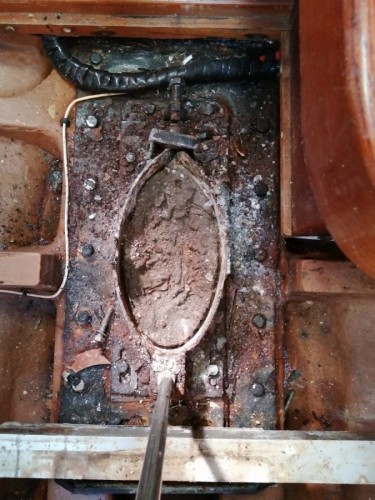Do you want to be informed on new Posts on this Thread? (members only)
| Sail & Rigging - Corrosion mast foot |
|---|
|
Join Date: 12 October 2019
Posts: 7 |
||
|---|---|---|
|
Corrosion mast foot
Dear Lars
The mast was take out this week, how could you expect the bottom of the mast has corrosion and the shoe too. I have read in the forum everything about this problem and solutions by different owners but I still have any questions:
1.- Cut to the healthy part of the base of the mast and rebuild it with an inner sleeve keeping the length of the mast; using as a template the section to make the addition. Still pending assessment but the level of cut will be below the holes of the cross bolts that join the base of the mast and the shoe, approximately 2-3 cm of the base of the mast will have to be cut.
Question: what is the recommended length for the inner sheath of the mast if there are no signs of corrosion above?
If I have not misunderstood the inner sheath, is it supplemented below the cut with another aluminum section so that it is level with the mast surface and reinforces the part that replaces all section the cut part?
2.- Screw the internal sheath and the external insert of the cut to the mast with steel screws.
Question: Is it correct and sufficient or is some additional type of connecting element sheath recommended, between the inner, the outer distal sheath and de mast?
3.- Increase the size of the drainage holes on the edge of the base of the mast, in a photo of a 41 (Phillipe Swan 41; S&S Swan Maintenance - G10 or G11 on a mast foot February 2013) made 3 to improve drainage to the shoe and bilge.
Question: Are 3 drainage holes in the bow and two more lateral ones sufficient and what diameter?
4.- In the same forum you recommend making the shoe of the mast with aluminum G10 to eliminate the problem of corrosion between it and the mast; make drainage holes in the shoe of the mast and place a 5 mm G10 plate between the shoe and the steel plate on which it rests.
Question: If the G10 aluminum shoe is reproduced, the original is very deteriorated, how thick should it be and where should the drainage holes be placed in the bilges? I understand that the holes match the mast, it is correct?
I don't quite understand the recommendation to put a 5mm G aluminum plate between the mast shoe and the steel mast step plate?
I will send a photo.
I appreciate the information and any consideration on this matter.
PD: I followed your advice about winches and got 8 very good pairs from Lewmar Ocean Self tailing: 58, 50, 48 and 40 |
|
Join Date: 02 January 2008
Posts: 1547 |
||
|---|---|---|
|
Dear I B 1. It is suggested that you cut the mast lower end just above the cable holes, and make the inner sleeve twice as long as the cut away piece. The cable holes can go into the doubled area.
Right, there should also be a supporting sleeve replacing the cut away piece. The sleeves can be made of marine aluminium sheet, the thickness need not be exactly the same, would be preferably to have a little excess, but they need to be rolled to a shape very close to the mast tube.
For the screwing arrangements look at the mast splice halfway up the mast, but here it is sufficient to have just four rows of screws, two staggered rows in the upper half of the inner sleeve, and two staggered rows in the supporting sleeve. It is not necessary to use countersunk screw heads here.
2. Screws are sufficient
3. The recommendation is to make two big drain holes in the shoe, maybe 50 mm diameter, but there must be the same size holes in the mast step in the same location.
Big holes will improve ventilation of the bilge.
4. It is preferable to make the mast shoe of aluminium, then it will not cause corrosion to the mast. The bottom plate could be 10 mm and the vertical part 6 mm. Two big drain holes near the center.
G-plate is a plastic material, and if put between the aluminium mast shoe and the steel mast step will prevent galvanic corrosion.
More questions?
It appears this mast has never been taken down based on the amount of scrap in the shoe. The drain holes have been blocked, and water has been standing inside.
The recommendation is to take off the elkhide cover from the mast, and check if there is hidden corrosion. Wet elkhide can cause such problems.
Kind regards
Lars
|
|
Join Date: 12 October 2019
Posts: 7 |
||
|---|---|---|
|
Dear Lars Thanks for the advice on the rehabilitation of the mast and his shoe. The boat is already inside the shipyard and many of the tips read on the forum are very useful. Very grateful, Jose  16/4/2020   |
|
Join Date: 02 February 2007
Posts: 202 |
||
|---|---|---|
|
Hello dear SWAN FANS! It is of course very difficult to speak after our dear professor! But I cannot stop myself doing it anyway...! I beleive that you must also try to avoid water ingress between the sleeves and the mast, which leads to galvanic corrosion. I think it is of the utmost importance. What I did on our Soeur Anne'mast was to use West System epoxy mixture (making it thick enough with silica) and heating it with an electric blanket to make sure it did harden enough, after tightening all the screws of the sleeves. Another possibility would be polyurethane such as Sikaflex 291, but its not as strong as epoxy? All the best to all... and definitely waiting to go sailing again ... as in the old days! Philippe. 41/022 |
|
Join Date: 02 January 2008
Posts: 1547 |
||
|---|---|---|
|
Dear Philippe
|
- Threads : 1715
- Posts : 10273
- Members: 823
- Online Members: 0

